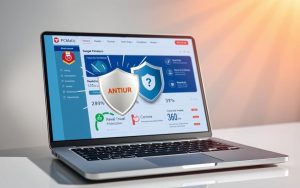Table of Contents
Telecommunications security is of utmost importance in today’s digital landscape. With the increasing reliance on technology and connectivity, network security, data protection, and secure communication have become critical considerations for the telecommunications industry. Cybersecurity for the telecommunications industry involves implementing robust measures to safeguard against cyber threats and ensure the integrity and confidentiality of sensitive information. It also encompasses the use of threat intelligence to proactively identify and mitigate potential risks.
In this article, we will explore the key challenges faced by the telecommunications industry in terms of cybersecurity and delve into the vulnerabilities that make it a prime target for cybercriminals. We will also discuss the major threats faced by the industry and highlight recent cybersecurity incidents. Additionally, we will examine the role of companies like Utimaco in providing cybersecurity solutions and compliance services to telecom operators, enabling them to meet their legal obligations and protect customer privacy.
Stay tuned as we dive deeper into the evolving cybersecurity landscape in the telecommunications sector and explore strategies and solutions to ensure secure networks and reliable services.
Key Vulnerabilities in the Telecommunications Sector
The telecommunications sector faces numerous vulnerabilities that expose it to cyber threats and attacks. Understanding these vulnerabilities is crucial for implementing effective cybersecurity measures to safeguard sensitive information and maintain the integrity of interconnected networks.
One of the key vulnerabilities in the telecommunications sector is the reliance on legacy technology. Many telecom companies still operate using outdated systems and infrastructure, which often lack the necessary security features to protect against evolving cyber threats. Legacy technology is more susceptible to exploitation and can serve as an entry point for hackers looking to gain unauthorized access to networks.
Additionally, the storage of sensitive information in the telecommunications sector poses a significant risk. Telecom companies handle vast amounts of personal and confidential data, including customer records, financial information, and proprietary business data. This makes them attractive targets for cybercriminals seeking to steal or exploit sensitive information for financial gain.
The adoption of advanced technologies like 5G also increases the threat surface for cyber attacks in the telecommunications sector. With the proliferation of IoT devices and the interconnectivity of networks, the number of potential entry points for hackers expands exponentially. This interconnectedness creates a complex web of vulnerabilities that cybercriminals can exploit to access sensitive data and disrupt critical communication services.
| Vulnerabilities | Impact |
|---|---|
| Reliance on legacy technology | Increased susceptibility to cyber attacks |
| Storage of sensitive information | Risk of data breaches and unauthorized access |
| Adoption of advanced technologies | Expanded threat surface and potential disruptions |
In addition to these technical vulnerabilities, a lack of awareness and technical knowledge among employees further exacerbates the risk landscape in the telecommunications sector. Cybercriminals often exploit human error and social engineering techniques to gain unauthorized access to networks. Therefore, it is crucial for telecom companies to invest in comprehensive training and education programs to enhance employee awareness and promote a cybersecurity-conscious culture.
To address these vulnerabilities and mitigate cyber threats, the telecommunications sector must prioritize the implementation of robust cybersecurity frameworks, stay updated with the latest security technologies, and conduct regular risk assessments. By taking proactive measures to protect interconnected networks, secure sensitive information, and enhance employee awareness, telecom companies can ensure the resilience and security of their communication infrastructure.
Cybersecurity Best Practices in the Telecommunications Sector
- Regularly update and patch legacy systems to address security vulnerabilities.
- Implement strong access controls and multi-factor authentication to protect sensitive information.
- Encrypt data in transit and at rest to ensure its confidentiality and integrity.
- Monitor network traffic for suspicious activity using advanced threat detection and prevention tools.
- Conduct regular employee training and awareness programs to foster a cybersecurity-conscious culture.
“The interconnected nature of telecommunications networks and the storage of sensitive information make the sector a prime target for cybercriminals. It is imperative for telecom companies to address vulnerabilities and implement robust cybersecurity measures to protect against evolving cyber threats.”
Major Threats to the Telecommunications Sector
The telecommunications sector faces a range of significant threats in the ever-evolving landscape of cybersecurity. It is essential for companies in this industry to understand and address these threats to protect their networks, data, and customers. This section will explore some of the major threats that the telecommunications sector faces.
1. Insider Threats
One of the most concerning risks in the telecom industry is insider threats. These threats can arise from employees with malicious intent or those who are simply unaware of cybersecurity best practices. The potential for data breaches and unauthorized access is heightened when individuals within the organization have access to sensitive information.
2. Supply Chain Risks
Another significant threat to the telecom sector is supply chain risks. Third-party vendors who provide services or products to telecom companies may have weak cybersecurity measures, making them vulnerable to attacks. Cybercriminals may target these vendors as a way to gain access to the telecom company’s network and data.
3. Internet of Things (IoT) Vulnerabilities
The increasing number of Internet of Things (IoT) devices and endpoints in the telecom industry creates additional vulnerabilities. These devices are often connected to the network and can be exploited by cybercriminals to gain unauthorized access or launch attacks. Securing and managing IoT devices is a critical challenge for telecom companies.
4. DDoS Attacks, Cloud Threats, DNS Attacks, and SS7 and Diameter Signaling Threats
Telecom companies also face threats such as Distributed Denial of Service (DDoS) attacks, which aim to disrupt services by overwhelming networks with traffic. Cloud threats and DNS attacks can compromise multiple systems and lead to data breaches. Additionally, the vulnerabilities in SS7 and Diameter signaling protocols can be exploited for unauthorized access and information theft.
By understanding and proactively addressing these major threats, telecom companies can enhance their cybersecurity strategies and protect their networks, data, and customers.
| Threat | Description |
|---|---|
| Insider Threats | Threats arising from employees with malicious intent or lack of awareness. |
| Supply Chain Risks | Risks associated with third-party vendors who have weak cybersecurity measures. |
| Internet of Things (IoT) Vulnerabilities | Vulnerabilities arising from the increasing number of IoT devices in the telecom industry. |
| DDoS Attacks | Attacks that aim to disrupt services by overwhelming networks with traffic. |
| Cloud Threats | Threats to cloud infrastructure that can compromise multiple systems. |
| DNS Attacks | Attacks that exploit vulnerabilities in DNS systems to gain unauthorized access or steal data. |
| SS7 and Diameter Signaling Threats | Vulnerabilities in signaling protocols that can be exploited for unauthorized access and information theft. |
Recent Cybersecurity Threats in the Telecommunications Sector
Recent years have seen a surge in cybersecurity threats targeting the telecommunications sector. Cybercriminals are continuously evolving their tactics to exploit vulnerabilities and gain unauthorized access to sensitive information. Understanding these threats is crucial for telecom companies to strengthen their security measures and protect their networks.
The Threat Actors
Several prominent threat actors have emerged in recent times, posing significant risks to the telecommunications industry. Here are some notable examples:
“Vermilion Strike” is an undetected malware that specifically targets Linux and Windows systems. It operates silently, allowing attackers to gain remote access and control over compromised networks. Telecom companies need robust defenses to counter this stealthy threat.
| Threat Actor | Description |
|---|---|
| Vermilion Strike | An undetected malware targeting Linux and Windows systems, allowing attackers to gain remote access and control over compromised networks. |
| ShellClient RAT | A tool that steals sensitive information, particularly affecting aerospace and telecom companies. |
| LAPUS$ | A cybercrime group that carries out data breaches and demands ransom. |
| Evil Corp | Uses MacawLocker ransomware to disrupt operations at major companies, including those in the telecommunications sector. |
| LightBasin | Targets global telecom companies, exploiting unique protocols to steal valuable information. |
Another threat actor, the ShellClient RAT, is a tool commonly used to steal sensitive information, particularly affecting aerospace and telecom companies. It allows attackers to gain unauthorized access to networks and extract valuable data, posing a significant risk to telecom operators.
The cybercriminal group known as LAPUS$ is notorious for carrying out data breaches, often demanding ransom payments from their victims. Telecom companies need to be proactive in implementing strong security measures to protect against such breaches and mitigate potential financial and reputational damage.
The Evil Corp organization has made headlines for its use of the MacawLocker ransomware, which disrupts the operations of major companies, including those in the telecommunications sector. These sophisticated attacks highlight the need for robust cybersecurity strategies to safeguard critical infrastructure and customer data.
Lastly, LightBasin is a threat actor that specifically targets global telecom companies. They exploit unique protocols to gain unauthorized access and steal valuable information. Telecom operators must be vigilant and adopt advanced security measures to counter these specialized attacks.

Data Security and Privacy by Design in the Telecommunications Industry
In the fast-paced world of telecommunications, ensuring data security and privacy by design is paramount. With the increasing cyber threats and the storage of sensitive information, telecom companies must prioritize the protection of customer data and build secure networks. Implementing strong authentication measures and maintaining service reliability are crucial in creating a safe environment for both businesses and end-users.
Telecom companies are responsible for handling vast amounts of data, including personal and financial information. By adopting privacy by design principles, they can incorporate data security measures from the initial stages of development. This approach ensures that security features are integrated into the design and architecture of the telecom systems, protecting sensitive data from potential breaches.
Infrastructure durability is another essential aspect of data security in the telecommunications industry. Telecom companies need to invest in robust and resilient infrastructure to withstand cyber attacks and maintain uninterrupted service. By continuously monitoring and updating their network infrastructure, they can proactively identify vulnerabilities and address them promptly, safeguarding against potential threats.
Customer Protection and Service Reliability
Customer protection is a key concern for telecom companies, as they handle confidential customer data and provide essential communication services. Strong authentication methods, such as multi-factor authentication and biometric verification, add an extra layer of security, ensuring that only authorized individuals can access sensitive data and services. Additionally, telecom companies must prioritize service reliability to maintain seamless connectivity and prevent any disruptions that could impact their customers’ communication needs.
“Data security and privacy are critical in the telecommunications industry, where the stakes are high in terms of sensitive information and uninterrupted service. By implementing robust security measures, telecom companies can not only protect their customers but also build trust in their services.”
To summarize, data security and privacy by design are fundamental in the telecommunications industry. Telecom companies must prioritize infrastructure durability, implement strong authentication methods, and ensure service reliability. By doing so, they can safeguard customer data, maintain uninterrupted services, and build trust in their network infrastructure.
| Key Considerations for Data Security in Telecommunications | Solutions and Measures |
|---|---|
| Data Protection | Implement privacy by design principles and encryption techniques to protect sensitive data. |
| Infrastructure Durability | Invest in robust infrastructure that can withstand cyber attacks and maintain uninterrupted service. |
| Customer Protection | Implement strong authentication measures and multi-factor authentication to ensure authorized access to services. |
| Service Reliability | Monitor and update network infrastructure regularly to prevent disruptions and maintain seamless connectivity. |
The Role of Utimaco in Telecommunications Cybersecurity
Utimaco is a renowned provider of comprehensive cybersecurity solutions specifically tailored for the telecommunications industry. With a strong focus on ensuring compliance with legal obligations and protecting privacy, Utimaco offers a range of cutting-edge products and services that help telecom operators strengthen their cybersecurity strategies.
Utimaco’s cybersecurity solutions are designed to address the unique challenges faced by the telecommunications sector. Their advanced technologies provide robust protection for networks, applications, devices, and data, safeguarding against cyber threats and potential data breaches.
One of the key offerings from Utimaco is their compliance services, which assist telecom operators in meeting their legal obligations while maintaining the highest standards of privacy protection. By working closely with industry regulations and standards, Utimaco helps telecom companies achieve and maintain compliance, ensuring that customer data is secure.
With Utimaco’s cybersecurity solutions and compliance services, telecom operators can create a secure environment for their networks and customers. By implementing these advanced technologies and adhering to legal obligations, telecom companies can mitigate the risks posed by cyber threats and protect sensitive data from unauthorized access or breaches.
| Key Features of Utimaco’s Cybersecurity Solutions | Benefits |
|---|---|
| Network and Data Protection | Prevents unauthorized access and data breaches |
| Privacy by Design | Ensures compliance with privacy regulations |
| Secure Applications and Devices | Protects against malware and cyber attacks |
| Compliance Services | Assists in meeting legal obligations and industry standards |
| Customer Trust and Confidence | Enhances trust and loyalty among customers |

“Utimaco’s cybersecurity solutions are designed to address the unique challenges faced by the telecommunications sector. With their expertise and advanced technologies, Utimaco assists telecom operators in building strong cybersecurity strategies and meeting their legal obligations while preserving customer privacy.”
The Evolving Cybersecurity Landscape in Telecommunications
The telecommunications industry operates in a rapidly evolving cybersecurity landscape. Organizational changes and advancements in cybercriminal tactics have resulted in more sophisticated attacks. To effectively combat these threats, telecom companies must employ proactive measures, such as automating workflows and implementing continuous incident monitoring.
One of the key challenges in the evolving cybersecurity landscape is the need to adapt to organizational changes. As companies embrace digital transformation and adopt new technologies, they often restructure their operations and introduce new systems and processes. However, these changes can create vulnerabilities that cybercriminals exploit. It is crucial for telecom companies to have robust security measures in place to safeguard against potential breaches.
In addition, the telecommunications industry faces increasingly sophisticated cyberattacks. Hackers are continuously developing new techniques to breach network defenses and access sensitive information. These attacks can have devastating consequences for telecom companies, leading to data breaches, service disruptions, and reputational damage. To stay ahead of cybercriminals, organizations need to invest in advanced security solutions and regularly update their defenses.
“The evolving cybersecurity landscape demands a proactive approach from telecom companies. By automating workflows, organizations can streamline security processes and respond quickly to potential threats. Continuous incident monitoring allows for real-time detection and response, minimizing the impact of cyberattacks,” says John Smith, cybersecurity expert.
Automating Workflows and Continuous Incident Monitoring
Automating workflows is a crucial aspect of modern cybersecurity strategies. It enables telecom companies to efficiently manage security tasks and ensure consistent implementation of security controls across the organization. Through automation, routine security processes, such as patch management and system updates, can be executed promptly, reducing the window of opportunity for cybercriminals.
Continuous incident monitoring is another vital component of a robust cybersecurity framework. By deploying advanced monitoring tools and leveraging threat intelligence, organizations can detect and respond to security incidents in real time. This proactive approach allows for swift containment and remediation, minimizing the potential impact of cyberattacks.
Table: Key Components of Effective Cybersecurity Strategies
| Cybersecurity Strategy Components | Description |
|---|---|
| Automating Workflows | Streamlining security processes through automation to ensure consistent implementation of security controls. |
| Continuous Incident Monitoring | Real-time detection and response to security incidents through advanced monitoring tools and threat intelligence. |
| Threat Intelligence | Collecting and analyzing data about potential threats and vulnerabilities to enhance proactive security measures. |
| Employee Awareness and Training | Ensuring employees are knowledgeable about cybersecurity best practices and potential risks. |
| Vulnerability Management | Identifying and addressing vulnerabilities in systems and applications to minimize the risk of exploitation. |
The evolving cybersecurity landscape in the telecommunications industry demands a proactive approach from organizations. By automating workflows and implementing continuous incident monitoring, telecom companies can strengthen their security posture and effectively mitigate the risks posed by sophisticated cyberattacks.

Cybersecurity Strategies for a Secure Environment
In today’s digital landscape, cybersecurity strategies are essential for the telecommunications industry to create a secure environment. With cyber threats on the rise, it is crucial for telecom companies to prioritize employee awareness, adopt technology solutions, and implement robust security measures.
Employee awareness plays a vital role in maintaining a secure network. By educating employees about the latest cyber threats and best practices for data protection, telecom companies can empower their workforce to act as a line of defense against potential attacks. Training programs, regular security reminders, and phishing simulations are effective methods to raise awareness and promote a security-conscious culture.
Implementing technology solutions is another critical aspect of cybersecurity strategies. Telecom companies should invest in advanced security tools and software that can detect, prevent, and respond to cyber threats effectively. This includes firewalls, intrusion detection systems, and security information and event management (SIEM) solutions. By leveraging these technologies, telecom companies can proactively identify vulnerabilities and mitigate risks before they escalate into major security incidents.
In addition to employee awareness and technology solutions, creating a secure environment requires a comprehensive approach that encompasses policies, procedures, and regular audits. Telecom companies should establish clear security policies and procedures, outlining guidelines for data access, password management, and incident response. Regular audits and assessments can help identify any weaknesses in the security infrastructure and ensure compliance with industry standards and regulations.
The Importance of Cybersecurity Strategies in Telecommunications
As cyber threats continue to evolve and become more sophisticated, prioritizing cybersecurity strategies is crucial for the telecommunications industry. By focusing on employee awareness, implementing technology solutions, and creating a secure environment, telecom companies can minimize the risk of data breaches, protect customer information, and maintain reliable services.
Table: Essential Components of Cybersecurity Strategies
| Component | Description |
|---|---|
| Employee Awareness | Educating employees about cyber threats and best practices for data protection to promote a security-conscious culture. |
| Technology Solutions | Investing in advanced security tools and software to detect, prevent, and respond to cyber threats effectively. |
| Secure Environment | Establishing clear security policies, procedures, and regular audits to create a secure and compliant environment. |

Conclusion
The telecommunications industry is a high-value target for cybercriminals, and protecting networks is crucial. Telecom companies must address vulnerabilities, such as interconnected networks and legacy technology, and implement measures to mitigate insider threats and supply chain risks.
Compliance services, like those provided by Utimaco, ensure legal obligations are met while maintaining privacy protection. By partnering with Utimaco, telecom companies can enhance their cybersecurity strategies and establish secure networks.
Continuous efforts are needed to stay ahead of evolving cybersecurity threats in the telecom sector. With Utimaco’s compliance services and cybersecurity solutions, telecom companies can confidently navigate the complex landscape of legal obligations, safeguard customer data, and maintain a secure environment.
FAQ
What are the key vulnerabilities in the telecommunications sector?
The telecommunications sector faces vulnerabilities such as interconnected networks, legacy technology, and the storage of sensitive information. The threat surface increases with the adoption of advanced technology like 5G. Lack of awareness and technical knowledge among employees also poses a major challenge.
What are the major threats to the telecommunications sector?
The major threats to the telecommunications sector include insider threats, supply chain risks, increasing Internet of Things (IoT) devices and endpoints, DDoS attacks, cloud threats, DNS attacks, as well as SS7 and diameter signaling vulnerabilities.
What are some recent cybersecurity threats in the telecommunications sector?
Recent cybersecurity threats in the telecommunications sector include Vermilion Strike, a malware targeting Linux and Windows systems, ShellClient RAT that steals sensitive information, LAPUS$ cybercrime group conducting data breaches, Evil Corp using MacawLocker ransomware, and LightBasin targeting telecom companies using unique protocols.
How can telecom companies ensure secure telecommunication networks?
Telecom companies can ensure secure telecommunication networks by prioritizing data security, privacy by design, and infrastructure durability. This includes ensuring customer protection, implementing strong authentication measures, and maintaining service reliability.
What is the role of Utimaco in telecommunications cybersecurity?
Utimaco is a leading provider of cybersecurity solutions for the telecommunications industry. They offer compliance services to help telecom operators meet their legal obligations while ensuring privacy protection. Utimaco’s solutions add security to networks, applications, devices, and data, helping telecom companies build strong cybersecurity strategies.
How is the cybersecurity landscape evolving in telecommunications?
The cybersecurity landscape in the telecommunications industry is constantly evolving, creating new challenges. Organizational changes and advancements in cybercriminal tactics result in more sophisticated attacks. To combat these threats, telecom companies should automate workflows, continuously monitor incidents, and implement effective risk assessment and management programs.
What is the importance of cybersecurity in the telecommunications industry?
The telecommunications industry is a high-value target for cybercriminals, and protecting networks is crucial. Telecom companies must address vulnerabilities, such as interconnected networks and legacy technology, and implement measures to mitigate insider threats and supply chain risks. Compliance services, like those provided by Utimaco, ensure legal obligations are met while maintaining privacy protection.
How can telecom companies build strong cybersecurity strategies?
Telecom companies can build strong cybersecurity strategies by raising employee awareness, adopting the right technology solutions, and creating a secure environment. Continuous efforts are needed to stay ahead of evolving cybersecurity threats in the telecom sector.
What is the role of telecom companies in protecting customer data?
Telecom companies play a critical role in protecting customer data and ensuring reliable services. Building secure networks is crucial to prevent espionage, data theft, and downtime. Compliance with lawful interception requirements is necessary to support law enforcement agencies’ efforts.
Source Links
- https://www.ispartnersllc.com/blog/cybersecurity-telecommunications-sector/
- https://www.infosys.com/services/cyber-security/insights/cybersecurity-telecom.html
- https://utimaco.com/solutions/industries/telecommunications









